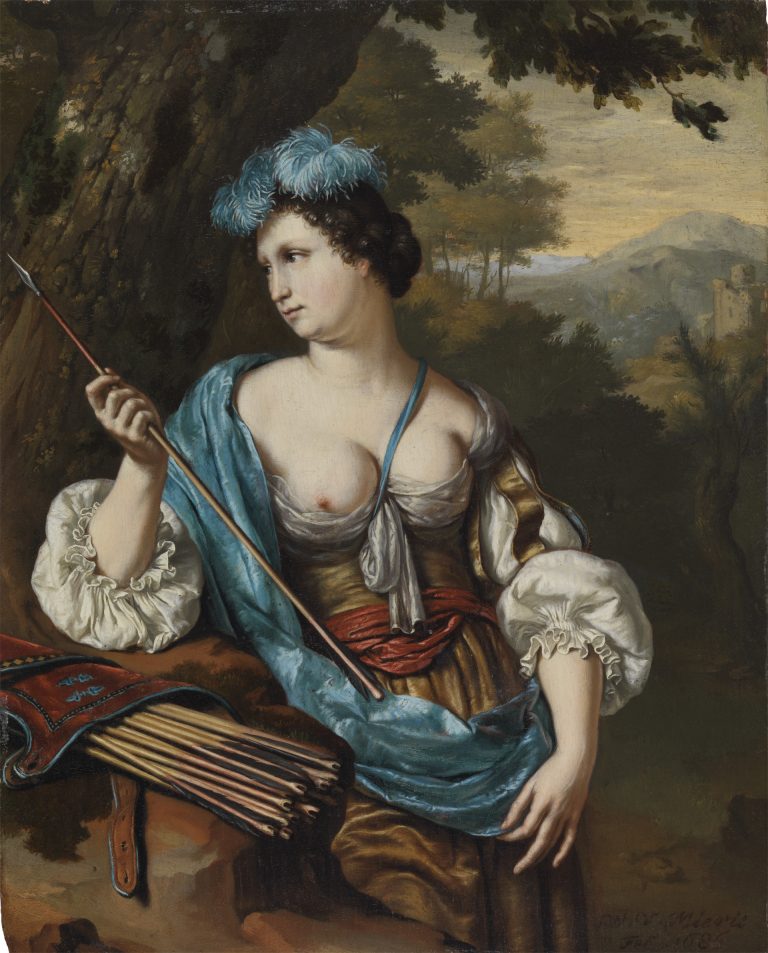Frans van Mieris the Elder (1635–81) trained his sons Jan (1660–90) and Willem in the fijnschilder tradition. Unfortunately, Jan died at a young age in Rome before he produced many works, but Willem continued to paint well into the eighteenth century. His works, which are rather slick in execution, were in great demand and fetched high prices. He painted many of the same subjects as his father, but he also produced many history pieces and, after 1700, kitchen and shop scenes. These pieces, with their Gerrit Dou–like stone window framing devices (fig 1), were fairly old-fashioned by this time, though they were still popular with collectors.1
Willem van Mieris painted this work in 1686 when he was about 24 years old. Here, a woman dressed à l’antique in a gold-colored robe with a red sash stands before an idealized hilly, wooded landscape opening up to ruins and a distant mountain. Van Mieris effectively used the muted tonalities of this evocative Arcadian landscape to set off the woman’s light-filled and sensual form. The delicacy of the artist’s painterly touch, so reminiscent of that of his father (see FM-103), is particularly evident in the shimmering blue of her scarf (fig 2) and in the individual brushstrokes that model the blue and white ostrich feathers in her hair.
The woman is without doubt meant to represent Diana, the goddess of the hunt, who is also known by her Greek name Artemis. Although the painter omitted the crescent moon, Diana’s primary attribute, she is depicted holding an arrow taken from the quiver lying on the rocky ledge before her. In Van Mieris’s day, Diana was associated with elegance and purity. The latter association may be somewhat surprising, as the woman’s plunging décolleté reveals a nipple that gives the painting an erotic charge.2 It is not known whether this painting had a pendant, but the gaze of the goddess would seem to suggest that there was one, probably Diana’s twin brother, Apollo, the patron god of music and poetry.3
At first glance, this scene with Diana appears to be a portrait historié, a painting in which a real person is depicted as a historical, biblical, or mythological figure, but this is far from certain.4 The painting was described as a portrait historié as early as 1842, when the English dealer John Smith published it as “A Young Lady, in the character of Diana.” Smith’s description was paraphrased in a Paris sales catalogue only two years later,5 and the notion that the painting is a portrait historié has appeared frequently in the literature.6 Diana’s face, however, lacks the kind of individualized features seen in Van Mieris’s female portraits.7 Her doll-like face with its double chin and thick neck resembles that of other stereotypical female figures in Van Mieris’s history paintings, as in his painting The Repentant Mary Magdalene, 1701 (fig 3). As Junko Aono has noted, Van Mieris’s paintings are populated by highly idealized women with “marble-like smooth skin, graceful poses and gestures and an almost sculpted classical profile.”8 Van Mieris used panels of almost the same size to paint other scenes of women from history, including a painting of Mary Magdalene dated 1709, in which the saint, like Diana here, is portrayed looking to the left in front of an idealized landscape.9
Portrait historié or not, this small jewel-like panel painting, which measures only 18 by 14.4 centimeters, is an exquisite example of Willem van Mieris’s skillful handling of paint at the beginning of his career. The smooth, blended brushstrokes he used to model the ivory-colored flesh tones and bolder touches he applied to accent the woman’s elegant wardrobe are techniques that helped establish his reputation as one of the finest painters of his day.
